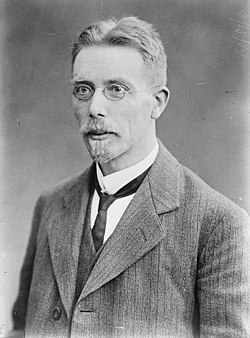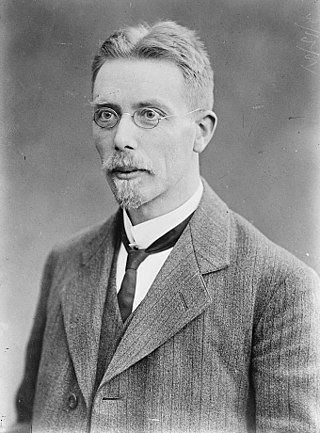August Krogh
Danish physiologist (1874–1949) From Wikipedia, the free encyclopedia
Schack August Steenberg Krogh ForMemRS[1] (15 November 1874 – 13 September 1949) was a Danish professor at the department of zoophysiology at the University of Copenhagen from 1916 to 1945.[2][3][4] He contributed a number of fundamental discoveries within several fields of physiology, and is famous for developing Krogh's principle.[5][6][7]
August Krogh | |
|---|---|
 Undated portrait of Krogh | |
| Born | Schack August Steenberg Krogh 15 November 1874 |
| Died | 13 September 1949 (aged 74) Copenhagen |
| Nationality | Danish |
| Alma mater | University of Copenhagen |
| Known for | Diffusing capacity for carbon monoxide Perfusion Krogh model Krogh length Krogh's principle |
| Spouse | Marie Krogh |
| Children | Erik Viggo Krogh Ellen Rigmor Krogh Agnes Helga Krogh Bodil Schmidt Nielsen |
| Awards | Baly Medal (1945) Croonian Medal (1940) ForMemRS (1937) Nobel Prize in Physiology or Medicine (1920) |
| Scientific career | |
| Fields | Zoophysiology |
| Institutions | University of Copenhagen |
| Thesis | Frøernes Hud- og Lungerespiration (1903) |
| Doctoral advisor | Christian Bohr |
| Notable students | Knut Schmidt-Nielsen Hans Ussing Torkel Weis-Fogh |
In 1920 August Krogh was awarded the Nobel Prize in Physiology or Medicine for the discovery of the mechanism of regulation of the capillaries in skeletal muscle.[8][9] Krogh was first to describe the adaptation of blood perfusion in muscle and other organs according to demands through opening and closing the arterioles and capillaries.[10]
Besides his contributions to medicine, Krogh was also one of the founders of what is today the Novo Nordisk company.[11]
Life
Summarize
Perspective
He was born in Grenaa on the peninsula of Djursland in Denmark, the son of Viggo Krogh, a shipbuilder. His mother (born Drechmann) was the daughter of a customs officer in Holstein. Through his mother’s family he claimed "a dash of" Romani blood . Krogh was educated at the Aarhus Katedralskole in Aarhus. He attended the University of Copenhagen graduating MSc in 1899 and gaining a doctorate PhD in 1903.[12]
Krogh was a pioneer in comparative physiology. He wrote his thesis on the respiration through the skin and lungs in frogs: Respiratory Exchange of Animals, 1915. Later Krogh took on studies of water and electrolyte homeostasis of aquatic animals and he published the books: Osmotic Regulation (1939) and Comparative Physiology of Respiratory Mechanisms (1941). He contributed more than 200 research articles in international journals. He was a constructor of scientific instruments of which several had considerable practical importance, such as the spirometer and the apparatus for measuring basal metabolic rate.
Krogh began lecturing in the University of Copenhagen in 1908 and in 1916 was promoted to full professor, becoming the head of the first laboratory for animal physiology (zoophysiology) at the university.[13]
Krogh was elected an International Honorary Member of the American Academy of Arts and Sciences in 1931,[14] an International Member of the United States National Academy of Sciences in 1937,[15] and an International Member of the American Philosophical Society in 1941.[16]
In the 1930s, Krogh worked with two other Nobel prizewinners, the radiochemist George de Hevesy and the physicist Niels Bohr on the permeability of membranes to heavy water and radioactive isotopes, and together, they managed to obtain Denmark's first cyclotron for experiments on animal and plant physiology as well as in dental and medical work.[13]
Foundation of Novo Nordisk
In 1922, August Krogh went on a lecture tour to North America after receiving the Nobel Prize in Physiology or Medicine. During this tour, he and his wife Marie, a doctor who was herself suffering from a type 2 diabetes, visited Toronto where the scientists Frederick Banting, Charles Best and John Macleod had just succeeded in manufacturing active insulin. Krogh received permission to manufacture insulin in the Nordic countries and joined forces with Hans Christian Hagedorn, a physician specialising in diabetes, to start the production of insulin in Denmark. This led to the establishment of Nordisk Insulinlaboratorium company in 1923.[11][17]
In 1925, brothers Harald and Thorvald Pedersen, who were former employees of Nordisk, formed their own company, Novo Terapeutisk Laboratorium. Novo and Nordisk competed until they merged in 1989 to become Novo Nordisk A/S.
Family
He married Marie Krogh (née Jørgensen, 1874–1943) in 1905. She was a renowned scientist in her own right and much of August Krogh's work was carried out in close collaboration with her.[10]
August and Marie had four children, the youngest of whom, Bodil, was born in 1918. She too was a physiologist, and became the first woman president of the American Physiological Society in 1975.[18] Bodil married another eminent physiologist, Knut Schmidt-Nielsen.[19][20]
Legacy
Torkel Weis-Fogh, an eminent pioneer on the study of insect flight, was a student of August Krogh's. Together they wrote a classic paper on that subject in 1951.[21]
Krogh's name is preserved in two items now named for him:
- Krogh length, the distance between capillaries which nutrients diffuse to, based on cellular consumption of the nutrients.[22][23]
- Krogh's principle, that "for... a large number of problems there will be some animal of choice, or a few such animals, on which it can be most conveniently studied."[24]
He via his book, The Anatomy and Physiology of Capillaries, popularized the false belief that if you were to lay out all the blood vessels from a human body they would reach 100,000 km in length. He made false assumptions about cappilary density while also using a hypothetical body that weighed 140 kg with 50 kg of pure muscle, an unrealistic physique, to get his round figure of 100,000 km. Recent finding suggest that the actual figure is somewhere between 9,000–19,000 km.[25]
Publications
- The Respiratory Exchange of Animals and Man (1916)
- Osmotic Regulation in Aquatic Animals (1939)
- The Comparative Physiology of Respiratory Mechanisms (1941)
Further reading
- Larsen, E. H. (2001). "August Krogh and the laboratory of animal physiology situated at Ny Vestergade 11". Ugeskrift for Laeger. 163 (51): 7240–7248. PMID 11797555.
- Kardel, T. (1999). "About the seven little devils who changed physiology. August and Marie Krogh on pulmonary gas exchange". Ugeskrift for Laeger. 161 (51): 7112–7116. PMID 10647306.
- Schmidt-Nielsen, Bodil, August and Marie Krogh. Lives in science, American Physiological Society, New York - Oxford 1995, pp. 295
- Schmidt-Nielsen, B. (1984). "August and Marie Krogh and respiratory physiology". Journal of Applied Physiology: Respiratory, Environmental and Exercise Physiology. 57 (2): 293–303. doi:10.1152/jappl.1984.57.2.293. PMID 6381437.
- Poulsen, J. E. (1975). "The impact of August Krogh on the insulin treatment of diabetes and our present status". Acta Medica Scandinavica. Supplementum. 578: 7–14. doi:10.1111/j.0954-6820.1975.tb06497.x. PMID 1098401.
- Dejours, P. (1975). "August Krogh and the physiology of respiration". Scandinavian Journal of Respiratory Diseases. 56 (6): 337–346. PMID 769148.
- Kenez, J. (1965). "The Capillaries and Krogh". Orvosi Hetilap. 106: 177–178. PMID 14275297.
References
External links
Wikiwand - on
Seamless Wikipedia browsing. On steroids.
